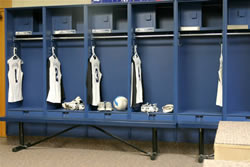It is mid-November, and I didn’t know this could happen: At least one NFL locker room does not smell.
You had to see the old Tampa Bay Buccaneers practice facility, called One Buc Place, to believe it. I’d be kind to say it was a shoebox. By the end of its run, in 2006, one office-sized room was shared by assistant coaches Raheem Morris and Jay Gruden, the NFL Network remote camera and backdrop and the airport X-ray machine the Bucs used to screen belongings before road trips (every team does this at its facility now, so officials and players and coaches can simply walk onto airport charter flights).
Food service was done in a hallway, and players ate on their laps at their narrow lockers. Mice, rats and opossums — and the cats that chased them — lived in, near and under the building and the adjacent office trailers for staff and the press. The trainers’ room had no modern amenities, and if trainer Todd Toriscelli wanted rehabbing players to do pool therapy, he put them in his car at lunchtime and drove 10 minutes to then-GM Rich McKay’s house, where the players would go in the shallow end of the family in-ground pool and jog for half an hour.
I’m serious.
I visited the Bucs’ two-year-old facility for the first time last Wednesday and Thursday and got a tour. It has the same kind of Ritz-Carlton luxuries that are becoming common around the NFL … of which your father’s football heroes would never have dreamed. (Dinner in the team dining room last Wednesday for the coaches and late-staying staff: Beef Wellington, Lobster Newburg, chicken-fried steak. (With a business channel on one high-def TV and ESPN on the other.) “It’s like the Waldorf-Astoria!” defensive coordinator Monte Kiffin gushed, filling his plate around 7 Wednesday night.
The place reminds me of what Paul Brown once said, shortly before he died in 1990, as some of the nicer training facilities started being built. “These places don’t help you win,” he said, and I agreed, but no one listened. One is nicer than the other these days, with the Bucs, Jets, Ravens and Seahawks the latest to build such palaces. I’ve softened a bit in recent years, because I realize one of the attractions is that teams like players hanging around when official work hours are over and before official work hours begin, so maybe they’ll put in more film study or lift an extra weight.
But I write this note because of what I noticed in the wood-paneled, spacious, Wi-Fi-enabled locker room. The room, on a 78-degree Tampa afternoon, was odor-free. I’ve been in NFL locker rooms for the last 25 years, and the one thing I’ve never smelled in any of them is nothing.
“Isn’t it fantastic?” said punter Josh Bidwell.
“You should have been at One Buc,” safety Jermaine Phillips said.”There was enough smell in there to last a lifetime.”
I was at One Buc. And there were enough smells to last lifetime. But here, before the place was built, coaches and executives and some veterans were asked for wish lists of what they’d like in the new facility. A couple of people wondered, “Can we cut down the smell in the locker room?” And so each of the 69 oversized lockers was outfitted with a complicated system to suck out odor and dry sweaty and wet equipment.
Each locker has a 30-inch-by-10-inch fine-mesh metal screen high in the stall, where the helmet and shoulder pads rest, and then a 30-inch-by-16-inch screen at torso level, to dry and suck out odors from practice gear and shoes. Other than it smelling nicer in the locker room, there’s a bacteria and infection benefit in sucking out many of the germs in the joint.
The exhaust from the lockers is removed when the temperature rises in the room (usually when a mass of bodies occupies it), and the air-conditioning automatically clicks on. That prompts a mechanism in the system that forces the air out of each locker through spiral ducts into a series of galvanized metal pipes, sent through a network of pipes 44 feet to the rooftop, and expelled into the air through a fan on the outside of the building. The theory: If the odor-causing items — shoes, pads, helmets, practice gear — are near or next to an exhaust system designed to suck nearby air out of the locker through two big vents, there won’t be any smell to linger.
What a country.
From Peter King’s Monday Morning QB column, posted on www.sportsillustrated.cnn.com, 11/17/08


